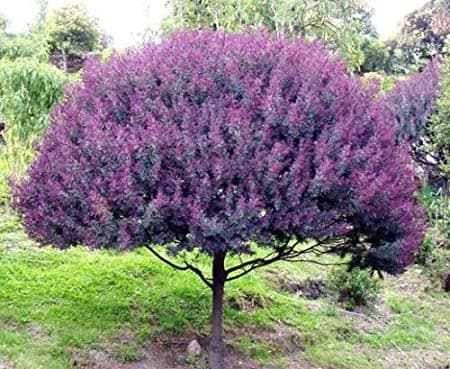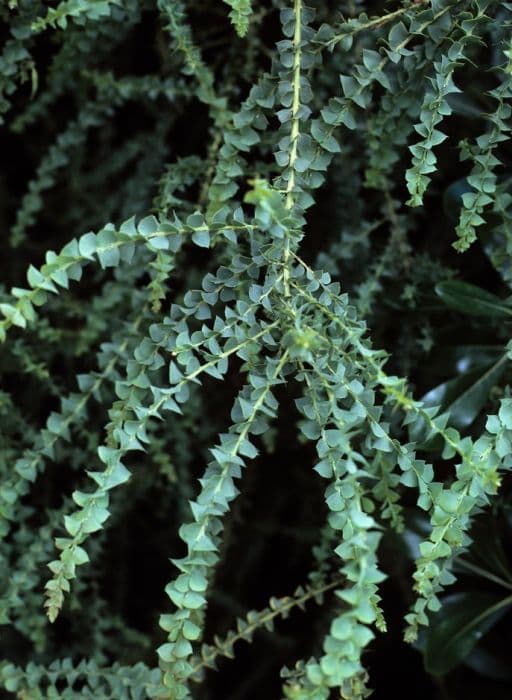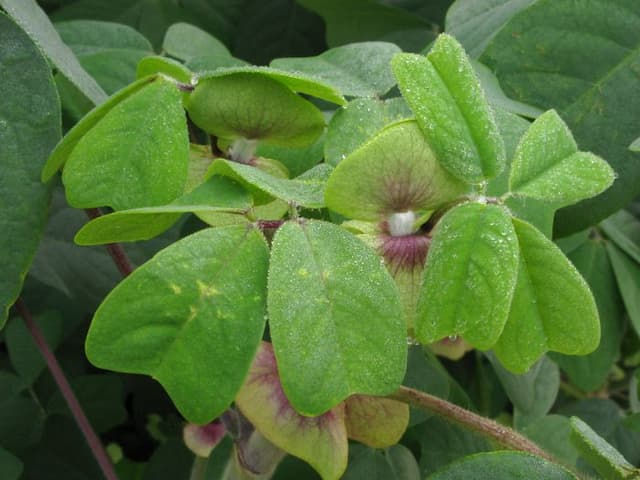Scarlet Runner Bean Phaseolus coccineus 'Red Knight'

ABOUT
The Red Knight, a variety of Scarlet Runner Bean, offers a striking visual appeal with its strong twining stems that eagerly climb up supports and trellises. The foliage is lush and vibrant green, creating a dense leafy backdrop. Its standout feature is the profusion of vivid red blossoms which appear as clusters, offering a brilliant contrast to the greenery. These showy flowers not only add a splash of color to any garden but also attract hummingbirds and other pollinators. Following the blooms, long, somewhat flattened green pods develop. These pods eventually mature to house the seeds, which can be both ornamental and edible when young. The entire plant displays a vigorous, robust growth habit, with the foliage, flowers, and pods all combining to make the Red Knight an attractive and productive addition to the garden.
About this plant
 Names
NamesFamily
Fabaceae.
Synonyms
Scarlet Runner Bean, Red Flowered Bean, Fire Bean, Mammoth, Red Giant, Scarlet Conqueror, Scarlet Emperor, White Dutch Runner, Case Knife Bean, Scarlet Runner.
Common names
Phaseolus multiflorus, Phaseolus coccineus.
 Toxicity
ToxicityTo humans
The common name for Phaseolus coccineus 'Red Knight' is runner bean. Runner beans are not toxic to humans when properly cooked; however, they do contain lectins, which can be harmful if the beans are eaten raw or undercooked. Symptoms of lectin poisoning can include nausea, vomiting, diarrhea, abdominal pain, and in severe cases, may lead to more serious health problems. Thorough cooking deactivates the lectins, making the beans safe to eat.
To pets
Runner beans, the common name for Phaseolus coccineus 'Red Knight', are not specifically listed as toxic to pets. However, as with humans, the raw beans contain lectins which can be harmful if ingested in large quantities. Symptoms of poisoning in pets can be similar to those in humans, including vomiting, diarrhea, and abdominal discomfort. Cooking the beans thoroughly removes the toxicity. It is always best to err on the side of caution and avoid feeding pets raw beans.
 Characteristics
CharacteristicsLife cycle
Perennials
Foliage type
Deciduous
Color of leaves
Green
Flower color
Red
Height
10 feet (3 meters)
Spread
5 feet (1.5 meters)
Plant type
Climber
Hardiness zones
6
Native area
Americas
Benefits
 General Benefits
General Benefits- Ornamental Appeal: Phaseolus coccineus 'Red Knight', commonly known as Scarlet Runner Bean, has bright red flowers that add a splash of color to gardens and can attract pollinators such as hummingbirds and bees.
- Edible Pods: The young pods of the Scarlet Runner Bean are edible and can be consumed cooked or raw, adding nutritional value to a variety of dishes.
- Edible Beans: Mature beans can be harvested and dried, providing a source of protein, fiber, and essential nutrients.
- Nitrogen Fixation: As a member of the legume family, Scarlet Runner Bean contributes to soil fertility by fixing atmospheric nitrogen, thus improving soil health.
- Climbing Habit: The plant's vigorous climbing growth habit allows it to be used as a natural screen or to cover trellises and fences, providing privacy and aesthetic value to landscapes.
- Companion Planting: When grown in proximity to other crops, Scarlet Runner Bean can offer benefits such as deterring certain pests and providing shade or support for less sturdy plants.
- Versatile Growth: This plant can thrive in a variety of soil types and conditions, making it a low-maintenance option for many gardens.
- Cultural Significance: The Scarlet Runner Bean has been a staple in various cultures' cuisines and gardening traditions, offering a connection to heritage and history for many growers.
 Medical Properties
Medical Properties- Diuretic effects: Some parts of the scarlet runner bean, which is a common name for Phaseolus coccineus, may promote increased urine production.
- Antioxidant properties: The beans contain antioxidants which can help in reducing oxidative stress in the body.
 Air-purifying Qualities
Air-purifying QualitiesThis plant is not specifically known for air purifying qualities.
 Other Uses
Other Uses- Dye Production: The Scarlet Runner Bean can be used to produce a natural dye from its flowers, often resulting in shades of pink and purple.
- Companion Planting: It is planted as a companion to other crops, such as corn or cucumbers, to provide them with natural support due to its climbing nature.
- Nitrogen Fixation: This plant contributes to enriching the soil with nitrogen, thereby supporting the growth of neighboring plants in a garden ecosystem.
- Living Structures: When grown over a frame, the Scarlet Runner Bean can form 'living' garden arches or tunnels, which are both decorative and functional.
- Wildlife Habitat: It can be used to create habitats for beneficial insects, as well as offering a food source for hummingbirds and butterflies with its vibrant flowers.
- Education: This plant is often used in schools or educational programs to demonstrate the life cycle of plants from seed to fruit.
- Agricultural Fodder: In some areas, the plant's foliage is used as fodder for livestock, particularly for rabbits and goats.
- Culinary Decoration: Edible flowers of the Scarlet Runner Bean can be used for garnishing and adding a pop of color to various dishes.
- Photography: Due to its striking flowers, the plant is often used as a subject in botanical photography and garden feature images.
- Fruit Contracts: The unripe pods are sometimes used in contracts between gardeners, with obligations to provide a certain amount to preserve heritage and heirloom vegetable varieties.
Interesting Facts
 Feng Shui
Feng ShuiThe Scarlet Runner Bean is not used in Feng Shui practice.
 Zodiac Sign Compitability
Zodiac Sign CompitabilityThe Scarlet Runner Bean is not used in astrology practice.
 Plant Symbolism
Plant Symbolism- Vitality: The vibrant red blossoms of the Scarlet Runner Bean represent energy, life force, and an active spirit.
- Passion: Red, often associated with love and desire, reflects the plant's ability to invoke intense emotions.
- Connection: The bean's climbing nature symbolizes interconnectedness, binding, and supportive relationships.
- Nourishment: As an edible plant, it symbolizes sustenance, providing both physical and spiritual nourishment.
- Growth: The fast-growing vines exemplify progress, personal development, and the expansion of ideas.
 Water
WaterScarlet runner beans should be watered deeply and evenly to keep the soil consistently moist. During their growing season, provide them with about 1 inch of water per week, either from rainfall or irrigation. Water at the base of the plant to avoid wetting the foliage, which can promote disease. During hot, dry periods, you may need to water them more frequently to maintain the moisture level. Ensure that the soil has good drainage to prevent waterlogging, which can cause root rot. When the plants are well-established, they may be more drought-tolerant and require less frequent watering.
 Light
LightScarlet runner beans thrive in full sunlight where they can receive at least 6 to 8 hours of direct sunlight daily. They will produce the best fruiting results if planted in a location that gets ample sun throughout the day. Avoiding overly shaded areas will help in preventing disease and encouraging vigorous growth and flowering. Partial shade can be tolerated, but it may reduce the plant's productivity.
 Temperature
TemperatureScarlet runner beans grow best in a temperature range of 60°F to 75°F. They can tolerate a minimum temperature of around 50°F; however, frost can severely damage or kill the plants, so they should be protected if temperatures are expected to fall below this. The maximum temperature for optimal growth is around 85°F, beyond which the plant could suffer from heat stress, especially if not adequately watered.
 Pruning
PruningScarlet runner beans do not usually require rigorous pruning, but it's beneficial to pinch off the tips of the plants once they reach the top of their support to encourage lateral growth and more flowers. Removing dead or yellowing leaves and occasional thinning can improve air circulation and reduce disease risks. Prune these beans when they are dry, ideally in the mid-morning once the dew has evaporated, to minimize the spread of diseases. The best time for any significant pruning would be early in the season or after harvest.
 Cleaning
CleaningAs needed
 Soil
SoilThe Scarlet Runner Bean, commonly known as Phaseolus coccineus 'Red Knight', thrives in a soil mix that is rich, well-draining, and has a pH between 6.0 and 7.5. An ideal soil mix would be equal parts garden soil, compost, and a material like perlite or sand to ensure proper drainage.
 Repotting
RepottingScarlet Runner Beans should be replanted annually as they are typically grown as annuals. They do not necessarily need repotting throughout the growing season unless they outgrow their space or containers.
 Humidity & Misting
Humidity & MistingScarlet Runner Bean plants prefer moderate humidity levels but are adaptable to a wide range of conditions. They do not require particularly high humidity to thrive.
 Suitable locations
Suitable locationsIndoor
Place in bright light and use a tall support for climbing.
Outdoor
Provide full sun, well-draining soil, and sturdy support.
Hardiness zone
5-11 USDA
 Life cycle
Life cyclePhaseolus coccineus 'Red Knight', commonly known as the Scarlet Runner Bean, begins its life cycle when a seed is planted and germinates, typically in the warm soil of late spring or early summer. The seedling emerges from the soil, producing a few pairs of leaves and begins to develop a twining stem that searches for support to climb. As it grows, the plant develops compound leaves and rapidly extends its vine structure, often reaching several feet in length. By mid-summer, bright red or sometimes white flowers bloom and attract pollinators such as bees and hummingbirds, which are crucial for the fertilization of the flowers resulting in the formation of bean pods. The pods mature, varying in length, with each pod containing several seeds that are either eaten when tender or left to dry on the plant for harvest. At the end of the growing season, the plant withers and dies with the onset of cold weather or frost, but the saved seeds can be replanted the following year, continuing the plant's life cycle.
 Propogation
PropogationPropogation time
Spring-Early Summer
The Phaseolus coccineus 'Red Knight', commonly known as Scarlet Runner Bean, is typically propagated by seed. The most popular and effective method of propagating these beans is direct sowing in the ground once the risk of frost has passed and soil temperatures have warmed to at least 60 degrees Fahrenheit (16 degrees Celsius). To encourage germination, it's advisable to soak the seeds in water for a few hours up to overnight before planting. Plant the seeds about 1 inch deep (2.54 centimeters) and space them roughly 6 inches apart (15.24 centimeters). The seeds will usually germinate within 8 to 14 days. It is important to provide a trellis or support for the vines to climb as they grow, and keep the soil moist but not waterlogged during the germination period.









